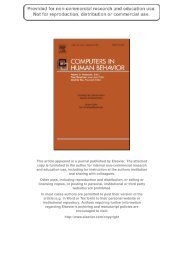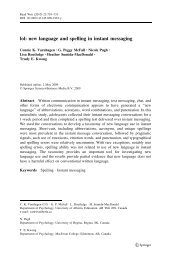Whitty.pdf
Create successful ePaper yourself
Turn your PDF publications into a flip-book with our unique Google optimized e-Paper software.
1850 M.T. <strong>Whitty</strong> / Computers in Human Behavior 24 (2008) 1837–1850<br />
Short, J. A., Williams, E., & Christie, B. (1976). The social psychology of telecommunications. New York: John<br />
Wiley and Sons.<br />
Sproull, L., & Kiesler, S. (1986). Reducing social context cues: Electronic mail in organizational communication.<br />
Management Science, 32, 1492–1512.<br />
Suler, J. (2004). The online disinhibition effect. CyberPsychology and Behavior, 7, 321–326.<br />
Turkle, S. (1995). Life on the screen: Identity in the age of the Internet. London: Weidenfeld and Nicolson.<br />
Utz, S. (2000). Social information processing in MUDs: The development of friendships in virtual worlds. Journal<br />
of Online Behavior, 1(1). Accessed 7.2.05.<br />
Walther, J. B. (1996). Computer-mediated communication: Impersonal, interpersonal and hyperpersonal<br />
interaction. Communication Research, 23, 3–43.<br />
Walther, J. B., Slovacek, C., & Tidwell, L. (2001). Is a picture worth a thousand words? Photographic images in<br />
long-term and short-term computer-mediated communication. Communication Research, 28, 105–134.<br />
<strong>Whitty</strong>, M. T. (2003a). Cyber-flirting: Playing at love on the Internet. Theory and Psychology, 13(3), 339–357.<br />
<strong>Whitty</strong>, M. T. (2003b). Pushing the wrong buttons: Men’s and women’s attitudes towards online and offline<br />
infidelity. CyberPsychology and Behavior, 6(6), 569–579.<br />
<strong>Whitty</strong>, M. T. (2004). Cyber-flirting: An examination of men’s and women’s flirting behaviour both offline and on<br />
the internet. Behaviour Change, 21(2), 115–126.<br />
<strong>Whitty</strong>, M. T. (2005). The ‘realness’ of cyber-cheating: Men and women’s representations of unfaithful internet<br />
relationships. Social Science Computer Review, 23(1), 57–67.<br />
<strong>Whitty</strong>, M. T. (2007a). Manipulation of self in cyberspace. In B. H. Spitzberg & W. R. Cupach (Eds.), The dark<br />
side of interpersonal communication (2nd ed., pp. 93–118). Mahwah, NJ: Lawrence Erlbaum Associates.<br />
<strong>Whitty</strong>, M. T. (2007b). The art of selling one’s self on an online dating site: The BAR approach. In M. T. <strong>Whitty</strong>,<br />
A. J. Baker, & J. A. Inman (Eds.), Online matchmaking (pp. 57–69). Houndsmills: Palgrave Macmillan.<br />
<strong>Whitty</strong>, M. T. (in press). Revealing the ‘real’ me, searching for the ‘actual’ you: Presentations of self on an<br />
internet dating site. Computers in Human Behavior, doi:10.1016/j.chb.2007.07.002.<br />
<strong>Whitty</strong>, M. T., & Buchanan, T. (in press). Looking for love in so many places: Characteristics of online daters and<br />
speed daters. Interpersonal: An International Journal on Personal Relationships.<br />
<strong>Whitty</strong>, M. T., & Carr, A. N. (2005). Taking the good with the bad: Applying Klein’s work to further our<br />
understandings of cyber-cheating. Journal of Couple and Relationship Therapy, 4(2/3), 103–115.<br />
<strong>Whitty</strong>, M. T., & Carr, A. N. (2006). Cyberspace romance: The psychology of online relationships. Basingstoke:<br />
Palgrave Macmillan.<br />
<strong>Whitty</strong>, M., & Gavin, J. (2001). Age/sex/location: Uncovering the social cues in the development of online<br />
relationships. CyberPsychology and Behaviour, 4, 623–630.<br />
<strong>Whitty</strong>, M. T. & Joinson, A. N. (in press). Truth, lies and trust on the internet. London: Psychology Press,<br />
Routledge.<br />
<strong>Whitty</strong>, M. T., & McLaughlin, D. (2007). Online recreation: The relationship between loneliness, internet selfefficacy<br />
and the use of the internet for entertainment purposes. Computers in Human Behavior, 23(3),<br />
1435–1446.<br />
Winnicott, D. W. (1971/1997). Playing and reality. London: Tavistock.<br />
Wolak, J., Mitchell, K. J., & Finkelhor, D. (2003). Escaping or connecting? Characteristics of youth who form<br />
close online relationships. Journal of Adolescence, 26, 105–119.<br />
Wysocki, D. K. (1998). Let your fingers to do the talking: Sex on an adult chat-line. Sexualities, 1, 425–452.<br />
Wysocki, D. K., & Thalken, J. (2007). Whips and chains? Content analysis of sadomasochism in internet personal<br />
advertisements. In M. T. <strong>Whitty</strong>, A. J. Baker, & J. A. Inman (Eds.), Online matchmaking (pp. 178–196).<br />
Houndsmills: Palgrave Macmillan.<br />
Young, K. S. (1998). Caught in the net: How to recognise the signs of internet addiction and a winning strategy for<br />
recovery. New York: John Wiley and Sons.<br />
Young, K. S. (1999). Internet addiction: Evaluation and treatment. Student British Medical Journal, 7, 351–352.
















